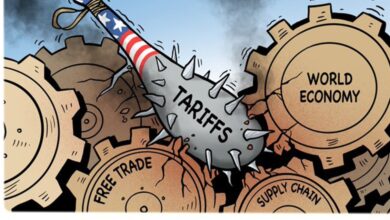Global Debt On The Rise – Goes Above $313 Trillion!
The global debt has seen a significant rise from the last decade. US is on the top of the list of countries in debt.

The level of debt has soared in recent years to unprecedented heights that raise eyebrows amongst economists and policymakers. A new report reveals global debt now stands at nearly $315 trillion in 2024, which is around 330% of the global GDP, a level nearly three times higher than just a decade ago at about $210 trillion. All these piled-up debts would add up to nothing but a sorry doom touching not only the economies and financial markets but the very lives of people across the world.
An Overlook –
Global debt adds up neither in one region’s confines nor in one economic bloc. In fact, it has been a cooperative game of play between developed and emerging economies. Half of the increase in debt around the world in the last ten years actually comes from the developed economies: the United States, Germany, and France.
 However, emerging markets like China, India, Russia, Argentina, Malaysia, and South Africa have also seen steep rises in their debt levels.
However, emerging markets like China, India, Russia, Argentina, Malaysia, and South Africa have also seen steep rises in their debt levels.
The most glaring example is China, whose total debt has almost increased 3x since 2000 and has now reached a level of approximately 288% of GDP. Growth reflects both China’s aggressive pursuit of growth and the fact that it increased its degree of financial integration with the rest of the world even further.
Public debt has risen in advanced economies. Starting with Japan, the government debt stands at a staggering 252 percent of GDP, second is the US which stands at 127 percent, and third one is the UK which stands at 106 percent. These percentages have risen by 116 percent, 71 percent, and 69 percent between the years 2000 and 2024.
So many events have fueled this world debt explosion. For one thing, the degree of dependence on debt-capitalized economic activity is expanding. And the best example of this is our own country which is looking forward to borrow Rs 6.61lakh crores in the next quarter.
Then there is the spillover pressure from the aftermath of the 2008 global financial crisis. Now more countries’ economies are aligning themselves with the fiscal policies of their governments, which has influenced the overall economic plays of the COVID-19 pandemic. Here, virtually all governments around the world have incurred large degrees of debt from stimulus packages that keep their respective economies floating.
 United States: Head Over Heels In Debt
United States: Head Over Heels In Debt
As the world’s biggest economy playing an oversized role in the global debt narrative, the U.S. is likely to deliver a fiscal 2024 deficit of around $1.8 trillion-or about 6.5% of GDP, according to the Congressional Budget Office. That’s one mighty deficit on top of an already humongous national debt.
Due to the pandemic, government spending has gone through the roof in the US. Having spent around $10 trillion over approximately nine years since its inception, the government expenditure currently goes around two trillion dollars more than long-run annual-levels. Although in a time of crisis, indispensable for shoring up the economy, it has considerably added to the debt burden of the nation.
Emerging Markets: The Increasing Debt Burden
Even though developed economies have always been at the forefront of the creation of debt, the developing markets are not way behind.
Emerging market debt has grown rather swiftly, which is to over $105 trillion in the first quarter of 2024. It is more than double of what it used to be a decade ago.
| HOUSEHOLDS | Non-financial Corporates | GOVERNMENT | Financial Sector | TOTAL DEBT | |
| Global Debt | $59.1 T | $94.1 T | $91.4 T | $70.4 T | 315.1 |
| Mature markets debt | $39.9 T | $50. 2 T | $63.0 T | $56.5 T | 209.7 |
| Emerging markets debt | $19.2 T | $44.0 T | $28.4 T | $13.9 T | 105.4 |
Amongst some of the examples that have dramatically improved their debt in the last two decades are China, India, Brazil, and South Africa.
Perhaps most remarkable is the case of China. Aggregate debt has risen from around 140% of GDP in 2008 to about 288% in 2024. Indeed, most of that increase can be attributed to China’s investment-driven growth model and the economy’s efforts to get going after facing various shocks-pandemic overtones included and the global financial crisis.
Other emerging markets also posted significant debt growth. For instance, Brazil failed in this regard mainly because of high public debt attributed to political instability and broad economic problems. In South Africa, it is partly because of the state-owned firms that had to be bailed out and needed the government to increase their growth.
The same increase in debt levels has peculiar side effects of risks specific to emerging market economies. Such economies, for instance, are relatively vulnerable to shocks (the ongoing war in the middle-east derived the oil prices through the roof) derived from changes in investor sentiments across the globe or alterations in currency fluctuations.
Therefore, challenges are faced by the managers, for example, the policymakers in such economies: to maintain an optimum level of debt without destroying the growth and stability of the economy.
 The Fallouts of Global Debt –
The Fallouts of Global Debt –
The spillovers of increased global debt are very far reaching and, in some circumstances, potentially vicious. Such levels of debt can really impose harsh constraints on the ability of a country’s response in any manner if a future economic shock arises, as the experience of COVID-19 so richly illustrates. It showed us the courses such countries ended up taking were pretty well predetermined by the fiscal space available to implement any stimulus measures considered necessary.
High debt also leads to what economic pundits refer to as “debt deflation.” This is the phenomenon whereby the overhang of borrowings lowers consumption and, therefore, lower investments due to low demand. This situation creates in a vicious cycle whereby firms and households cannot meet their obligations in terms of servicing debt, and the result is defaults and instability in the financial sector.
The International Monetary Fund said, “Delaying adjustment will simply mean that a larger correction is needed eventually, and waiting can also be risky because experience shows that high debt and lack of credible fiscal plans can trigger adverse market reactions and can limit the room that countries have to deal with future shocks.”
Furthermore, high debt tends to expose the economy to the risk of financial repression – a situation under which governments adopt policies that are aimed at diverting funds toward their highest priorities, to which debt servicing just so happens to be. Controls of interest rates, capital controls or enforced purchases of government debt by domestic banks are some of the typical expressions of such policies. All such policy choices have very adverse long-term consequences for the growth and stability of the economy.
Fighting the Growing Debt –
The global debt problem is a complex one and therefore, country-specific. Among the strategies the IMF expects to succeed are:
Widening tax bases and improving the efficiency of tax collection. This goes a long way in surging the revenues of governments without necessarily raising tax rates. And for a country like India- growing economy- where only 4-5% of the population pays taxes, it’s a must.
Reforms in progressive tax system in capital gain and income taxation should be undertaken in the highest possible extent. It alone could, quite easily reduce the problem of inequality of income and over time lead to collection of more revenues for the government.
Instead of cutting public investment or social spending, subsidies such as fuel subsidies have to be eliminated. The latter has an even worst-detrimental effect on growth.
Put in the markets an acceptable fiscal plan, which then could gain confidence and consequently give room for dealing with the shock of future economic circumstances.
However, debt reduction of this order will be highly problematic. Experience learnt from the years between World War I and World War II brings to knowledge that it normally requires some extraordinary circumstances or an extended period of very good economics to bring debt down by a significant margin.
This new wave of debt around the globe has shown that solutions aren’t going to be easy to come by. It has to put an end to all the economic reversion to sanity that is both management and political will. If anything, it’ll only be in the reassessment of our current economic models. It should be attacked by the rest of the world in concert because economies are so intricately connected with each other. Crisis in one country can easily jump over to the rest.
International debt is one of the graver financial crises faced by the world in the current scenario. And even if the emergent markets are highly indebted, the developed economies of the world contribute to it and yet attempt to dig themselves out of the pit. So this burden will be of prime importance in the future on how it can be maintained and decreased to ensure global economic stability and prosperity going forward.




